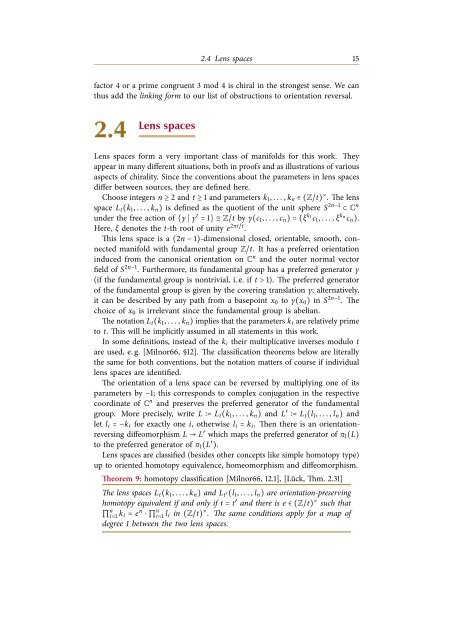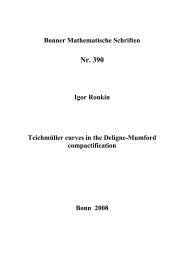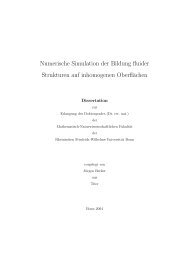Orientation reversal of manifolds - Universität Bonn
Orientation reversal of manifolds - Universität Bonn
Orientation reversal of manifolds - Universität Bonn
You also want an ePaper? Increase the reach of your titles
YUMPU automatically turns print PDFs into web optimized ePapers that Google loves.
2.4 Lens spaces 15<br />
factor 4 or a prime congruent 3 mod 4 is chiral in the strongest sense. We can<br />
thus add the linking form to our list <strong>of</strong> obstructions to orientation <strong>reversal</strong>.<br />
2.4<br />
Lens spaces<br />
Lens spaces form a very important class <strong>of</strong> <strong>manifolds</strong> for this work. They<br />
appear in many different situations, both in pro<strong>of</strong>s and as illustrations <strong>of</strong> various<br />
aspects <strong>of</strong> chirality. Since the conventions about the parameters in lens spaces<br />
differ between sources, they are defined here.<br />
Choose integers n ≥ 2 and t ≥ 1 and parameters k 1 , . . . , k n ∈ (Z/t) × . The lens<br />
space L t (k 1 , . . . , k n ) is defined as the quotient <strong>of</strong> the unit sphere S 2n−1 ⊂ C n<br />
under the free action <strong>of</strong> {γ ∣ γ t = 1} ≅ Z/t by γ(c 1 , . . . , c n ) = (ξ k 1<br />
c 1 , . . . , ξ kn c n ).<br />
Here, ξ denotes the t-th root <strong>of</strong> unity e 2πi/t .<br />
This lens space is a (2n − 1)-dimensional closed, orientable, smooth, connected<br />
manifold with fundamental group Z/t. It has a preferred orientation<br />
induced from the canonical orientation on C n and the outer normal vector<br />
field <strong>of</strong> S 2n−1 . Furthermore, its fundamental group has a preferred generator γ<br />
(if the fundamental group is nontrivial, i. e. if t > 1). The preferred generator<br />
<strong>of</strong> the fundamental group is given by the covering translation γ; alternatively,<br />
it can be described by any path from a basepoint x 0 to γ(x 0 ) in S 2n−1 . The<br />
choice <strong>of</strong> x 0 is irrelevant since the fundamental group is abelian.<br />
The notation L t (k 1 , . . . , k n ) implies that the parameters k i are relatively prime<br />
to t. This will be implicitly assumed in all statements in this work.<br />
In some definitions, instead <strong>of</strong> the k i their multiplicative inverses modulo t<br />
are used, e. g. [Milnor66, §12]. The classification theorems below are literally<br />
the same for both conventions, but the notation matters <strong>of</strong> course if individual<br />
lens spaces are identified.<br />
The orientation <strong>of</strong> a lens space can be reversed by multiplying one <strong>of</strong> its<br />
parameters by −1; this corresponds to complex conjugation in the respective<br />
coordinate <strong>of</strong> C n and preserves the preferred generator <strong>of</strong> the fundamental<br />
group. More precisely, write L ∶= L t (k 1 , . . . , k n ) and L ′ ∶= L t (l 1 , . . . , l n ) and<br />
let l i = −k i for exactly one i, otherwise l i = k i . Then there is an orientationreversing<br />
diffeomorphism L → L ′ which maps the preferred generator <strong>of</strong> π 1 (L)<br />
to the preferred generator <strong>of</strong> π 1 (L ′ ).<br />
Lens spaces are classified (besides other concepts like simple homotopy type)<br />
up to oriented homotopy equivalence, homeomorphism and diffeomorphism.<br />
Theorem 9: homotopy classification [Milnor66, 12.1], [Lück, Thm. 2.31]<br />
The lens spaces L t (k 1 , . . . , k n ) and L t ′(l 1 , . . . , l n ) are orientation-preserving<br />
homotopy equivalent if and only if t = t ′ and there is e ∈ (Z/t) × such that<br />
∏ n i=1 k i = e n ⋅ ∏ n i=1 l i in (Z/t) × . The same conditions apply for a map <strong>of</strong><br />
degree 1 between the two lens spaces.





